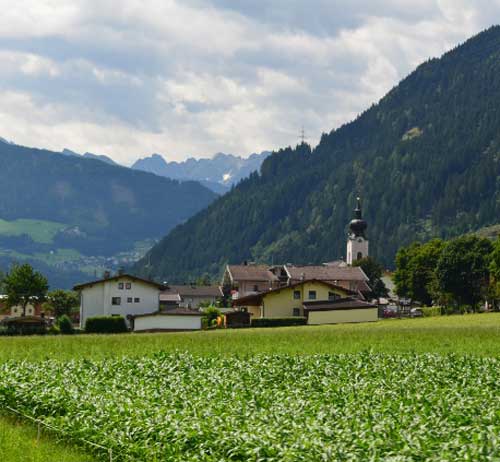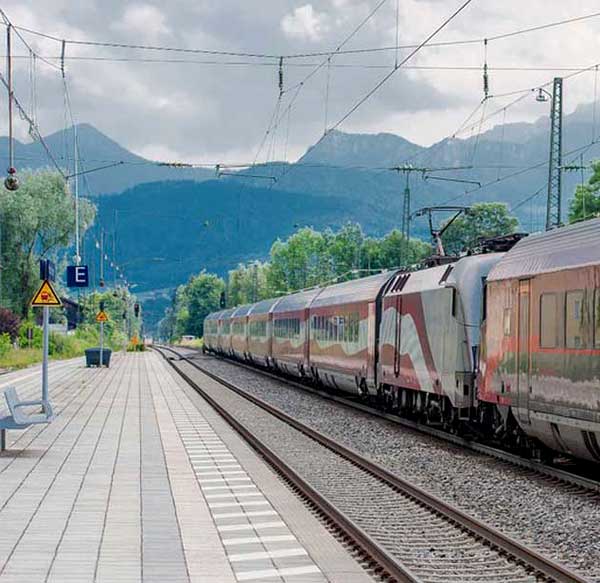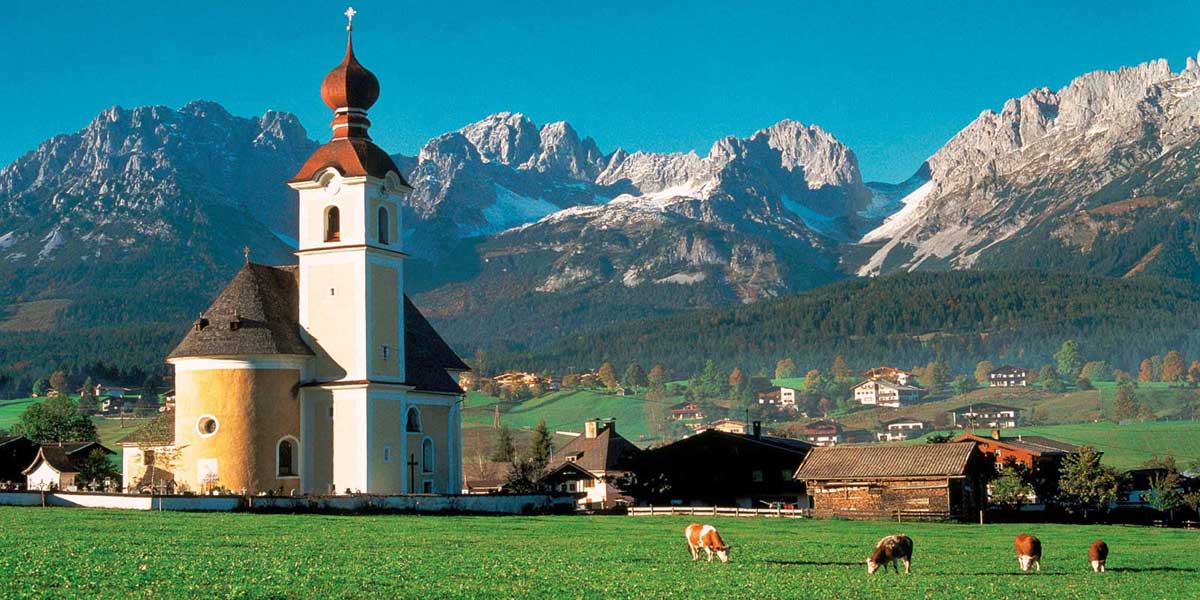Munich to Innsbruck by Rail

The train journey from Munich, Germany, to Innsbruck, Austria, is one where you pass a lot of really interesting places on the way, but most people who make the trip never stop to check them out. As the journey straight through takes less than two hours, there is plenty of time to make a day's journey out of it, and call in on some of the places on the way, As the train is a regional service, you don't have to make reservations, and since, with a rail pass, you can get on and off a train as much as you like, it's the perfect journey to make in stages over a day.

The only drawback is what do you do with your luggage at each stop. As out trip to Innsbruck was only going to be for a single day before returning to our base in Munich, we left our main luggage in Munich (it can be left at your hotel if you are going back there the next night, or else at the left luggage storage facility at Munich station), travelled lightly carrying only a backpack containing a single change of clothes for each of us, stayed overnight in Innsbruck, spent the next day sightseeing, then returned to Munich by train the next evening.
The Journey
Rosenheim
The first stop on the train to Innsbruck after leaving Munich (20 minutes from Munich) is Rosenheim, which is located on the west bank of the Inn River at the confluence of the rivers Inn and Mangfall in the Upper-Bavarian Alpine Foothills. A city of over 61,000 inhabitants, it is known for the many fine boutiques in the Old Town area.
Lokschuppe, located at Rathaus street, has changing exhibitions, which are usually well-known even outside the boarders of Rosenheim. Previous exhibitions were about Dinosaurs, Mummies, Tibet, Bionic, Maya, the Desert. Check out the webpage for the current exhibition. The Inn Museum on Inn street is dedicated to the river Inn and its use and importance for the region and ships and shipbuilding. The Museum is located in the Bruckbaustadel, a beautiful historical building dated back to the 17th century.
Much of the business and industrial part of the town was built after World War II. From the beginning of bombing raids on German cities in the spring of 1942 during World War II, Rosenheim was not spared. During 14 bomb attacks, 201 people were killed and 179 injured. The focus of the air attacks was the railway station and the railway tracks, as Rosenheim was an important transportation hub between Munich, Salzburg and Innsbruck.
Kufstein
The village of Kufstein is 50 minutes by train from Munich, making it around the half way point between Munich and Innsbruck. With a population of about 18,400, Kufstein is the second largest Tyrolean town after the state capital Innsbruck. The old city centre (Altstadt) has several picturesque lanes, the most famous of which is Romerhofgasse. The architecture style here is typical for Tirol region in Austria. A part of the medieval city wall has been preserved. Many visitors also come to the town for the large number of cultural events it hosts, including the Wine Festival, the Operetta summer Kufstein, the Magic Christmas on the fortress and the Pre New Year’s Eve party on December 30, as well as the "Day of 1,000 lights".
Kufstein's greatest landmark is Kufstein Fortress, which can be seen clearly from the train if you don't plan on stopping there. It was first documented in 1205 as a possession of the Bishop of Regensburg and the Duke of Bavaria. In the 19th century, Kufstein Fortress was turned into a bastille for political prisoners. The views from the top of the fortress are very nice. n the fortress itself , there are the permanent and also the changing exhibitions, which cover a variety of topics.
Kufstein funicular takes you directly from the city on the Brentenjoch mountain with its walking paths. In the surroundings, however, there is the 1,828 m high Hohe Salve mountain and charming holiday resorts. In winter, the holiday area Kufstein - Hohe Salve - Wildschonau marks the entrance to the largest ski resort of Austria - the SkiWelt Wilder Kaiser Brixental. One of the largest and most modern ski resorts in the world, its 280 kms of ski slopes provide endless skiing.
Worgl
Worgl, in the Austrian state of Tyrol, is 20 km from the state border with Bavaria and 34 minutes by train from Innsbruck. Worgl is an important railway junction between the line from Innsbruck to Munich, and the inner-Austrian line to Salzburg. Nearby Itter Castle was the site of one of the last European and most unusual battles of World War II. The Battle for Itter Castle was fought on May 5, 1945 by surrendered Wehrmacht troops, the United States Army, Austrian Resistance fighters and former French political prisoners against the 17th Waffen-SS Panzer Grenadier Division. Gerhard Berger, a former Formula One driver and former co-owner of Scuderia Toro Rosso, was born in Worgl.
The Water Adventure World WAVE on the Innsbruck road is the largest water world in the surroundings, offering 4,000 sqm of adventure tubes and wellness highlights. Also the so called "sauna residence of the Romans" with the Circus Maximus sauna, one of the largest sauna cabins in the world, is part of this facility. The town gives access to a vast network of trails which snake around and through the Tyrolean mountains.
Jenbach
Jenbach, which is 20 minutes by train from Innsbruck, has plenty to see and do for visitors but an hour is not enough if you want to see it all. The Museum of Local History focuses on topics such as nature, sports, railways and the history of the municipality. In summer the outdoor pool "Terrassenbad Jenbach" attracts plenty of people from all over. Other attractions are of course Lake Achensee and the world of mountains surrounding Jenbach. In winter, however, snowshoe hikes in the surroundings are really popular. The ice rink in the centre of the village, the 3 km long illuminated toboggan run Jenbach and the nearby skiing areas of the region Achensee and Karwendel and the Zillertal valley provide even more fun and action for your holidays.
The Achensee Railway, which is based in Jenbach and is operated by steam locomotives, is a tourist railway that operates on most days in the warmer months. The roughly 7 kilometre long rack railway leads, via two stops, to the Seespitz railway station on Lake Achensee, where it is met by lake ferries. At Jenbach Junction there are railway lines with three different gauges: 1,435 mm (normal railway line of the OBB, the national railway company), 1,000 mm (Achensee Railway) and 760 mm (Zillertal Railway).
The Emperor Franz Joseph I of Austria had the Achensee Railway railway built, overcoming the 7 km long track from Jenbach to Lake Achensee within 45 minutes. Also the Zillertalbahn Railway is a steam train that runs the 32 km from Jenbach to Mayrhofen in the Zillertal valley. During World War II the Heinkel factories at Jenbach produced motors for the Me-163, the first operational rocket engine powered airplane, and other parts for the V-2 missiles fired at southern English cities during the final months of the Second World War. Consequently, in February 1945, 31 tons of bombs were dropped on the railway station during Operation Clarion in order to prevent the Reichsbahn from transporting war-material. This was necessary for the impending invasion of Germany and Austria. The air attack on Jenbach destroyed 35 houses and left 8 people dead.
Lake Achensee, also called Fjord of the Alps, is the largest lake in Tyrol. Emerald-green to ultramarine, the colours of the 133 m deep Lake Achensee in Jenbach fascinate its visitors. Due to its extraordinary water quality the range of underwater vision amounts to up to 10 metres. The lake - 9,4 km long and 1 km wide - covers an area of 6.8 sqkm, impounding 481 millions of cubic metres of water. Lake Achensee is located in the heart of the Karwendel mountain chain, and is the largest protected area in Europe. Visitors who would like to enjoy the lake from a bird's eye perspective can scale the Barenkopf mountain. You can enjoy a great panoramic view on the mountain lake, shimmering in different colours, from the summit.
Lake Achensee can be reached from Jenbach using the Achensee Railway. In Achenkirch, located at the north lakeside, cold mountain streams join the lake and this is also where a headland has been constructed to make bathing more pleasant. Further localities at the lakeside are Pertisau, located at the west lakeside, as well as Maurach at the south east lakeside. These towns can be reached by ferry which leaves from near the railway station at Seespitz.
Pertisau is one of the best starting points for winter hikes and cross-country tours in Tirol's largest nature park, the Karwendel Nature Park. The Karwendel cable car takes skiers to the Zwolferkopf ski area, which provides special offers for families. Cross-country skiers will not only be delighted by the unique natural landscape in this nature conservation area, but also by the snow-covered slopes which enable you to do some smooth gliding all winter long, guaranteed.
Tratzberg Castle
Documented for the first time in the 13th century, Tratzberg Castle, near the town of Jenbach, was used as a border stronghold against the Bavarians and as Emperor Maximilian's I hunting lodge. In the late 15th century the former fortress was destroyed by fire. In 1590, Tratzberg came into the possession of the Fuggers, a well-known and wealthy family of merchants, who expanded the castle even further. Most of the now conserved inventory is from this time. Thanks to the family's dedication and efforts the 6800 sqm castle with its 5000 sqm shingle roof became a gem of a 16th century Tyrolean castle again. It is now one of the most important cultural monuments of the country and open to the public daily 10:00am - 5:00pm from late March to early November. Tratzberg Castle is a 3 km walk from the town centre.
Innsbruck
Innsbruck, the capital city of Tyrol in western Austria, is one of the country's 'must see' destinations. This city of 120,000 people lies about halfway between Munich in Germany and Verona in Italy, and it is the railway service between those two cities that we took from Munich to reach there. Innsbruck is an internationally renowned winter sports centre, and hosted the 1964 and 1976 Winter Olympics as well as the 1984 and 1988 Winter Paralympics. Innsbruck also hosted the first Winter Youth Olympics in 2012.
Design by W3layouts


